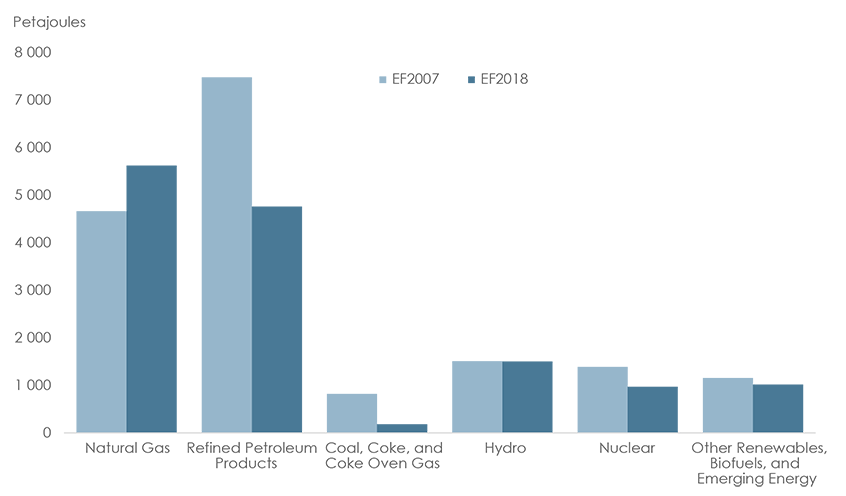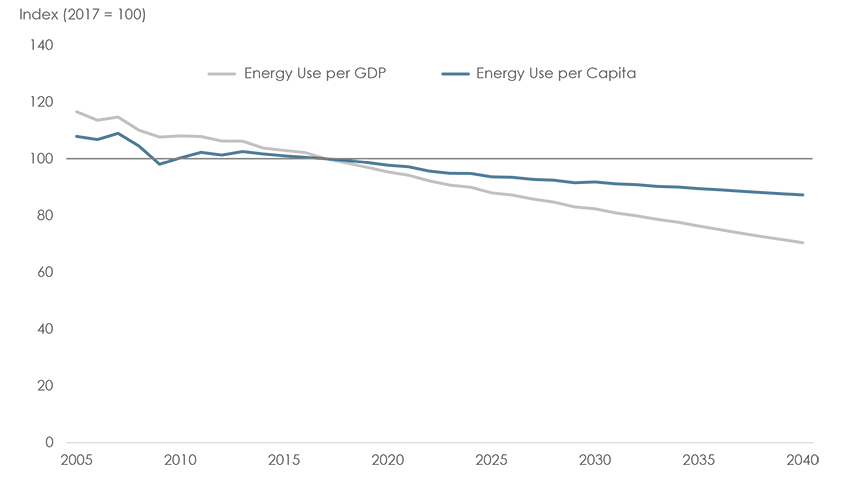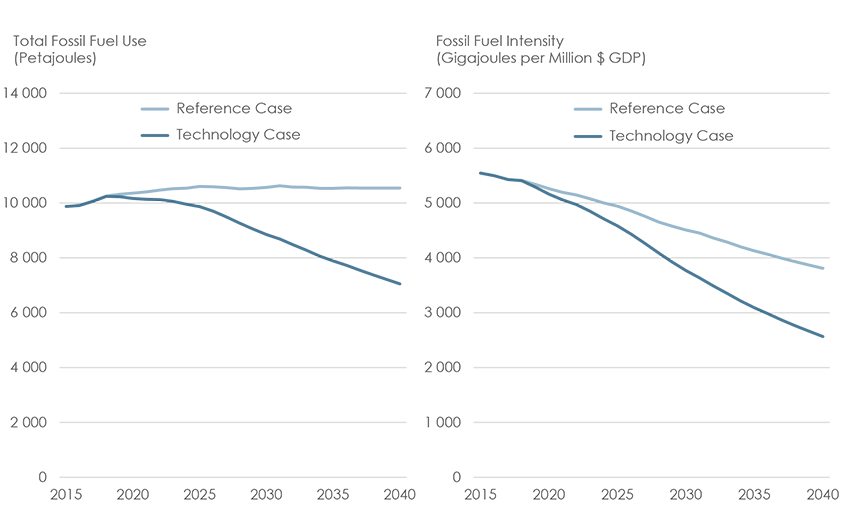Canada’s Energy Transition: Historical and Future Changes to Energy Systems – Update – An Energy Market Assessment

6. Future Pathways
It is challenging to predict exactly how the energy transition will unfold in Canada. Canada’s transitioning energy system may involve familiar methods of energy used in new ways. For example, using fossil fuels in more efficient ways, and developing more renewable sources of electricity for powering end-uses. The transition may also involve entirely new energy systems, such as advanced biofuels and electrolysis for hydrogen production. The pace of the transition will also place pressure on governments to develop regulations for new technologies as they emerge.
This section explores the current energy transition in a few ways. First, it looks at how past developments have influenced future expectations. This underscores that change from current perspectives should be expected. Second, it looks at what a low-carbon energy transition might mean for Canada’s current energy systems. Finally, this section explores possible future energy systems.
Changing Projections and New Perspectives
Chapter 5 described examples of the energy transition in Canada using historical data. Another way that current transitions can be measured is through how they have influenced future expectations. Over the last decade, many policy and technology trends have altered outlooks for energy supply and demand in Canada and beyond.
Several notable developments include:
- Coal phase-outs in power generation and falling natural gas prices reduced the expected role of coal.
- The emergence of fracking changed the outlook for oil and gas supply from scarcity to abundance.
- The combination of crude oil supply growth with improved vehicle efficiencies changed the discussion from peak oil supply to peak oil demand.
- Rapidly falling cost of renewables now allows them to compete on an energy basis with natural gas.
These changes have had significant implications for future perspectives on energy. Baseline energy supply and demand scenarios from BP and the IEA are projecting oil and coal demand either slowing considerably or peaking before 2040. Wind and solar PV, previously considered fringe energy sources or too expensive to compete with more traditional sources of energy, are now cost competitive with natural gas-fired generation.Footnote 56
The outlook for energy demand in Canada has changed considerably over the past decade too. The NEB’s Canada’s Energy Future (EF) report examines supply and demand fundamentals for Canadian energy under various scenarios. Figure 18 illustrates baseline (“Reference Case”) projections of primary energy demand mix by fuel for 2030 from projections made in 2007 and 2018. These projections trace how expectations of energy demand in Canada have evolved over the past decade. Most notably, the projection for 2030 demand for refined petroleum products has changed from 7 481 PJ in 2007 to 4 764 PJ in 2018.
Figure 18: Primary Energy Demand Projections for 2030: EF2007 vs. EF2018

Source: NEB – Canada’s Energy Future (2007 and 2018)
Description:
This column chart illustrates projections for primary energy demand in 2030 from EF reports authored in 2007 and 2018. The largest differences between the two reports can be observed with natural gas demand, refined petroleum product demand, coal demand, and uranium demand.
EF2007 projected 2030 natural gas demand at 4 666 PJ, while EF 2018 projected 2030 natural gas demand at 5 623 PJ. Refined petroleum products demand was 7 841 PJ in EF2007, but 4 764 PJ in EF2018. Coal demand was 820 PJ in EF2007, but 184 PJ in EF2018. Hydro demand was largely unchanged: 1 509 PJ in EF2007, and 1 504 PJ in EF2018. Uranium demand was 1 387 PJ in EF2007, but 971 PJ in EF2018. Other renewables (including biofuels and emerging energy) demand was 1 156 PJ in EF2007, and 1 019 PJ in EF2018.
The EF2018 Reference Case projects a very different energy system in Canada in 2030 from the EF2007 Reference Case. In brief, these differences are:
- Canadians use less energy: The projection for 2030 primary energy demand in EF2018 is 17% lower than in EF2007. This is a result of many factors including lower economic growth, policies and programs, energy efficiency regulations, and technological development.
- Coal is nearly phased out: Policy developments and the improved economics of natural gas lead to a large reduction in expected 2030 coal use between the two reports.
- Less energy from oil products: New vehicle fuel emission regulations are expected to improve average vehicle fuel economy. The EF2007 Reference Case did not include any future standards, while the EF2018 Reference Case includes passenger car and light duty standards covering 2012 to 2027 model years, and heavy freight standards covering 2014 to 2028 model years.
- More energy from natural gas: Natural gas prices fell substantially after the 2007 report, driven by technology changes. Growth in Canadian demand is related to use across the economy, with key demand areas being power generation to replace retiring coal units, and demands related to oil sands production growth.
- Less energy from nuclear: Nuclear is somewhat lower, as EF2018 includes Hydro-Quebec’s decision to decommission Gentilly Nuclear Generating Station in 2012, and Ontario Power Generation’s decision to retire Pickering Nuclear Generating Station by 2024 and only refurbish existing plants.Footnote 57
- Less energy from renewables, but more wind and solar: The EF2018 Reference Case projects over 36 PJ (or 10 TW.h) more wind and solar generation than the EF2007 Reference Case in 2030. However, this growth in wind is somewhat offset by lower expectations of biomass use in the industrial sector. Biomass use fell significantly after several closures in the pulp and paper industry following the 2008 recession.Footnote 58
While Figure 18 compares baseline Reference Case outlooks, it is also interesting to compare actual data against alternative scenarios. EF2007 included a scenario that balanced energy, environment, and economic outcomes (the “Triple E” scenario). This scenario envisioned a policy and technology push in Canada towards a lower carbon energy system. Figure 19 traces primary energy demand by fuel type from 2005 levels to 2017 actuals, and compares them to EF2007 Reference Case and Triple E projections. The graph shows that coal and oil demand followed the Triple E pathway more closely, while natural gas use followed the Reference Case pathway more closely. Renewable and non-emitting is moderately lower than projected, as declines in nuclear and industrial biomass offset growth in solar, wind, and transportation biofuels.
Figure 19: Primary Energy Demand: EF2007 Cases vs. Historical, 2005 – 2017
Source: NEB – Canada’s Energy Future (2007 and 2018)
Description:
This graph illustrates a comparison between EF2007 Reference Case and Triple E projections with respect to coal, natural gas, oil, and renewables/non-emitting primary energy demand in Canada between 2005 and 2017. The projections are compared to actual energy demand over the same period.
Moving to a Low Carbon Future
EF2018 shows various possibilities for future energy supply and demand. The EF2018 Reference Case reflects many of the transitions previously discussed in this report. Energy use is expected to slow relative to historical growth in all scenarios. This change in energy use is driven by energy efficiency improvements, technology, policy, and economic factors.
A noticeable shift is the decoupling of energy use from economic growth. The EF2018 Reference Case assumes a 20% increase in population and a 50% increase in real GDP between 2017 and 2040. However, total primary energy demand over that period increases only 5%. Figure 20 illustrates the continuing trend of declining energy demand per GDP and energy demand per capita from 2005 to 2040.
Figure 20: Primary Energy Demand Intensity: EF2018 Reference Case, 2005 – 2040

Source: NEB – Canada’s Energy Future (2018)
Description:
This line graph illustrates historical and projected energy use per real GDP and energy use per capita in Canada between 2005 and 2040. The data is displayed as an index with a base year of 2017. Energy use per GDP is projected to decline by 30% between 2017 and 2040 and energy use per capita is expected to decline 13% between 2017 and 2040.
Similar to EF2007’s Triple E scenario, EF2018’s “Technology Case” explores a scenario where a global move towards reduced GHG emissions is driven by stronger policies and a faster adoption of low-carbon technologies. This scenario has significant implications for Canadian energy systems, as illustrated in Figure 21. Under the Technology Case, Canada is projected to use 30% less fossil fuels than current levels by 2040. With real GDP assumed to grow by 50% between 2017 and 2040, fossil fuel use per GDP falls by 53% in the Technology Case versus a 30% decline in the Reference Case. The phase out of coal in Canada by 2030 and the further adoption of carbon sequestration technology reduces the emission intensity of the remaining fossil fuel mix. This implies that emissions will fall even faster than fossil fuel use.
Figure 21: Fossil Fuel Use and Intensity: EF2018 Reference vs. Technology Cases

Source: NEB – Canada’s Energy Future (2018)
Description:
This line graph illustrates projections from EF2018 with respect to total fossil fuel use in Canada and fossil fuel intensity. Between 2017 and 2040, total fossil fuel use in Canada is expected to increase from 10 075 PJ to 10 549 PJ in the EF2018 Reference Case. In the Technology Case, fossil fuel use is projected to decline to 7 054 PJ in 2040. Fossil fuel intensity, as measured in GJ per million $ of real GDP, is projected to decline from 5 431 to 3 809 between 2017 and 2040 in the Reference Case. Fossil fuel intensity is projected to decline to 2 564 in 2040 in the Technology Case.
The Technology Case is not a prediction or recommendation of certain policies, technologies, or outcomes. Rather, it is a scenario that looks at the effects of an accelerated transition towards a low-carbon economy on energy demand and supply for Canada.
Canada’s only official analysis of emissions performance and performance against climate commitments is published by ECCC. ECCC’s “Pathway to Canada’s 2030 Target” projects that measures under the Pan-Canadian Framework would result in an emissions reduction of 175 MT of CO2e by 2030. This represents a 23% reduction from Canada’s 2005 level of emissions – a shortfall of 44 MT. ECCC notes that its 175 MT estimate does not include emissions reductions that would result from other Pan-Canadian Framework commitments, such as investment in public transit, green infrastructure, innovation, and clean technologies. ECCC notes that these additional measures would put Canada on track to meet its Paris Agreement commitments.
The Transition Beyond 2030
EF2018’s Technology Case projects considerable progress towards a lower-carbon economy in Canada compared to past trends. However, it represents just one possible pathway towards a lower-carbon economy.Footnote 59 It is uncertain what the ultimate pathway will be. A shift towards the aspirational 1.5 degrees Celsius targetFootnote 60 in the Paris Agreement likely means an even faster and more drastic shift away from current trends by 2040. Importantly, Canada’s 2030 emissions target, and the 2040 horizon for the EF projections, only represent milestones in a longer transition. As noted in the IEA’s “Sustainable Development Scenario”, these 2040 projections only get the world on track for necessary emission reductions and imply further, and likely deeper, reductions beyond 2040.
In the Canadian context, several studies have looked at deep emission reductions by 2050 and beyond. These include the Deep Decarbonization Pathways Project (DDPP), the Institut de l’énergie Trottier, and ECCC’s Mid-Century Strategy.Footnote 61 The DDPP and Trottier reports illustrate that deep emission reductions are technically possible and will involve drastic changes to Canadian energy systems and the economy. The DDPP report cites Canada’s preparedness for deep decarbonization as “mixed”—while Canada is on the right path for electricity, buildings, and personal transportation; challenges remain with the decarbonization of heavy industry and oil and gas extraction.
In scenarios that show decarbonizing energy systems, fossil fuels continue to play an important, but declining, role in the global energy mix. For example, the IEA’s 2018 Sustainable Development Scenario shows that by 2040, global coal demand is less than half of current levels, global oil demand is 25 million barrels per day less than today, and natural gas use is higher than current levels (although lower than their baseline “New Policies Scenario”).Footnote 62 Analysis from DDPP and Trottier shows that even in deep decarbonization scenarios, fossil fuel use remains in certain sectors where alternatives are more costly or technologically more difficult.
There is an important trade-off between the pace of transition in the near term and the longer-term need for negative emissions technology. Footnote 63 An important dynamic in many decarbonizing scenarios is that the longer it takes to switch away from emitting energy sources, the greater the need for negative emissions in the longer term. For example, the Shell “Sky” scenario shows the globe getting to net-zero emissions by 2070, and removing approximately net 10 000 MT of CO2 per year to 2100 in order to keep global temperatures at levels consistent with the Paris Agreement.
Energy Systems of the Future
Projections of future energy supply and demand, even in scenarios such as the EF2018 Technology Case, are often grounded in current energy system realities. Energy systems are complex and it can be difficult to imagine how disruptive demand side or supply side changes will be. It is possible that new energy systems will emerge in Canada’s energy transition. Likewise, disruptions in energy use could affect Canada’s energy transition as well.
Table 3 provides an overview of several potential energy systems that are largely still in the research and development phase. Significant breakthroughs and cost reductions could lead to one or more of these individual systems increasing in the energy mix. There are a variety of energy options, some of which have been discussed for many years but currently have limited commercial implementation. If these technologies gain traction, they may provide alternate pathways in a transition towards a lower carbon future. Barriers to the adoption of these systems include costs, proven performance at a commercial scale, available feedstock, land-use implications, and infrastructure requirements.
Table 3: Future Energy Systems in Canada
| Energy | Production | Conversion | Distribution | End-Use |
|---|---|---|---|---|
| Next generation biofuels | Sustainable biomass from agricultural, municipal, and forestry waste | Thermochemical and biochemical processes convert biomass into ethanol. | Pipeline networks, truck, and rail. | Transportation, space heating, electricity generation |
| Renewable natural gas / biogas | Waste capture | No conversion required, but similar to natural gas, renewable natural gas would require processing to remove impurities. | Pipeline networks, truck or train (as liquefied or compressed natural gas) | Space heating, electricity generation, transportation, non-energy uses |
| Hydrogen | Electrolysis | Fuel cells convert hydrogen to electricity. | Pipeline or truck for use in combustion engines; electrical grid | Transportation, industry, electricity generation |
| Uranium | Mining | Uranium processing refines, enriches and converts uranium ore to fuel pellets and bundles for use in small modular reactors or in nuclear fusion. | Ship, rail, truck | Electricity generation, electricity generation in remote off-grid communities |
Source: NEB
End-Use Transitions
The energy transition will involve more than just changing the composition of where our energy comes from. There are also possibilities for changing how consumers use energy in the future. These changes could include technological changes to energy-using equipment, changes to how consumers use energy, or having consumers become energy producers themselves.
Table 4 provides several examples of potential changes that could occur to end-use demand. Future energy systems will involve connections between the changes too.Footnote 64 For example, the outcome on energy systems from autonomous vehicles could be quite different if EVs continue to gain ground relative to conventional-fuelled vehicles. Likewise, a large uptake of EVs would look different if accompanied by greater solar PV adoption. The advent of new digital technologies to manage electricity supply and demand more efficiently could further affect how energy systems are changed by autonomous vehicles and EVs.
Table 4: Examples of End-Use Transitions
| Energy-Using Technology | Changing Energy Services | Consumers Producing Energy |
|---|---|---|
|
|
|
Source: NEB
The increased role of electrification will also likely involve a modernized electricity grid. Through its analysis of increased digitalization and energy, the IEA notedFootnote 65 that electricity is the key sector for transforming energy systems in four key areas:
- Digitally-enabled “smart demand response”; where smart appliances connected to grids improve system flexibility and shift loads away from peak times.
- Integration of intermittent renewables, such as wind and solar.
- Optimizing EV charging for when there is excess supply and low costs.
- Facilitate development of distributed energy resources such as household solar photovoltaic and storage, and peer-to-peer electricity trading via new digital platforms such as blockchain.
The Pan-Canadian Framework supports the modernization of electricity systems in Canada. The Framework includes funding for projects that help electric systems use renewable energy better, expand renewable capacity, and facilitate the integration of energy storage for renewables.
- Date modified:
